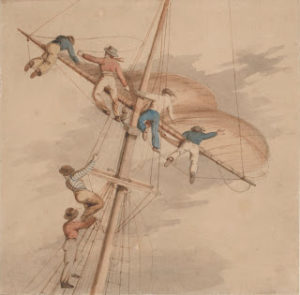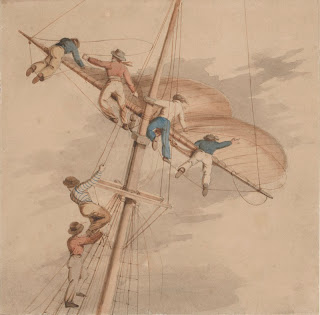There was an old whaling song that started “it’s a damn tough life full of toil and strife/ We whalermen undergo.” Sailors in the early US Navy didn’t have it much easier. Sure, there were more hands to do heavy lifting, and the voyages typically lasted only a few months, if that, before a warship dropped anchor in a secure port. And yet, daily existence on a warship was perhaps even more perilous than on a whaler or merchantman.
Just sailing a frigate, with its towering rig and enormous spread of sail, required an active crew. Racing aloft at the word of command from the quarterdeck was not for the faint of heart. Miraculously, only four of Constitution’s sailor fell while working in the rig during the War of 1812, but for nearly all of them it ended badly. Hitting the deck meant almost certain death. Hitting the water meant almost certain drowning. Nothing is soft when you land on it from a height of two hundred feet.

Working on deck had its own dangers. Moving heavy barrels into and out of the hold, or stowing boats presented plenty of opportunities for crushing finger and toes. The dangers to life and limb increased as the weather worsened. Seaman Joshua Place learned this the hard way. During a gale one night, he fell head first from his hammock and careened down the main hatch, struck a cable, and finally fell across a water cask. Carried into sickbay, the surgeon discovered he had severely injured his back and “ruptured his bowels.”
Working with the anchors proved especially dangerous. Seaman Nicholas Verplast was sent to Constitution’s hold to “fetch some large anchor stocks.” As they rose through the hatchway, one of them slipped from the slings, struck his hip and shoulder, and finally thrust his leg between some water casks. The wound was so severe that he could never return to work. Seaman John Hyatt had a similar run in with the anchor. Surgeon Amos Evans reported his accident:
Had his arm caught with the anchor this morning & had the anterior part of the wrist much cut & lacerated exposing & injuring some of the flexor muscles of the fingers. Brot [sic] the skin in contact & confined it by 2 stiches [sic] then applied pledgets of lint wet with Laud[anum] & a bandage over all. applied a Splint behind the arm & back of the arm hand to steady the hand & Keep the fingers straight. Keep the arm confined to the breast by a suspending bandage.
Seaman James Hilton was likewise “jammd by the anchor which hurt his chest. was bled & took cathartic. feels better.”
Of course, any of these injuries could have happened on a merchant vessel. A sailor on a warship had the added dangers of enemy action, or preparing for it. Crews spent many hours drilling at the guns. They knew a large iron cannon could be as dangerous to themselves as to the enemy. As Isaac Hull trained his crew at the gun on August 10, 1812, Ordinary Seaman John Wentworth couldn’t get out the way fast enough and a gun carriage rolled over his foot. The gun and carriage weighed over 6,000 lbs- after the accident the surgeon thought his toes looked “very much bruised.”Seaman Jonathon Ellis was even more unlucky. A recoiling gun “passed over his right knee.”
The worst injuries of all occurred in battle. Those men killed outright were frequently dumped unceremoniously overboard to clear the decks, and the exact cause of death was rarely noted. Those men killed or seriously wounded by freak accidents in an engagement often turn up in the records, however. Quartergunner Robert Brice made it into the ship’s log on August 19th. His death was occasioned “through want of precaution in not sponging his Gun being blown from the Muzzle of the piece.” He had tried to ram a cartridge down the muzzle of the gun before it had been swabbed out and a smoldering ember prematurely ignited the charge. During the battle with Java, Seaman Enos Bateman was “disabled by wounds received in both knees and his left wrist, by the blowing up of a cartridge.”
On wooden ships, splinters struck off by enemy shot caused huge numbers of casualties among the crews. During Constitution’s battle with HMS Cyane and HMS Levant in February 1815, a number of “Old Ironsides,” crew received debilitating splinter wounds. Vincent Marks caught one the left knee while serving the number three gun on the gundeck. David Quill, captain of the same gun, “received a severe splinter wound upon the elbow the effects of which still remain in interrupting the free motions of the joint.” Elsewhere, a splinter hit Andrew Chalmers’ left hand.
To get a sense of the desperate wounds caused by enemy shot and resulting splinters, have a look at the alarming film created by the Lake Erie Maritime Museum. Museum personnel built a mock-up of the side of a brig-of-war and then fired 24-pounder carronades at it. As you’ll see, the gundeck in battle, at least on a lightly-built ship, was a horrifying place. No wonder British sailors frequently called the middle of a ship the “slaughterhouse.”
The Author(s)
Matthew Brenckle
Research Historian, USS Constitution Museum
Matthew Brenckle was the Research Historian at the USS Constitution Museum from 2006 to 2016.
